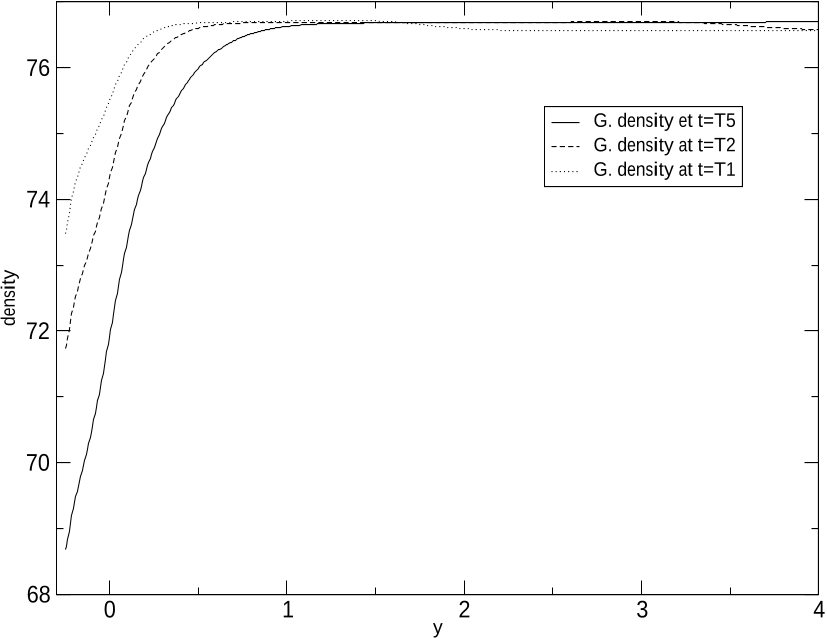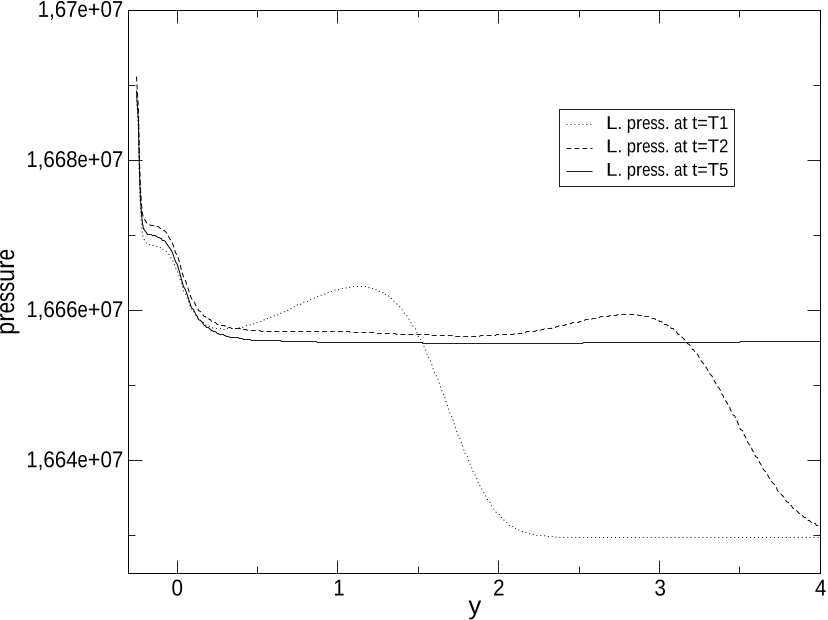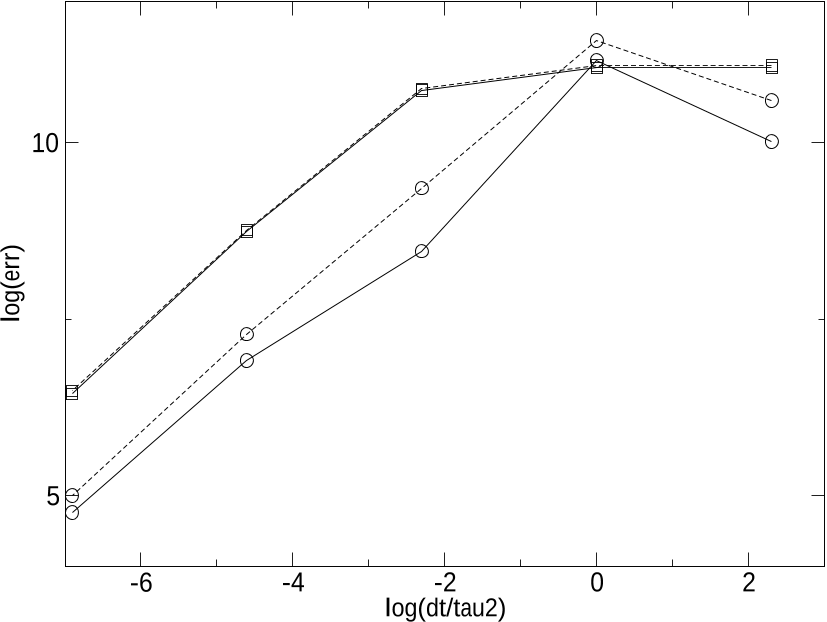A fractional step method to compute a class of compressible gas–liquid flows
Jean-Marc Hérard,Olivier Hurisse +1 more
Reads0
Chats0
TLDR
In this article, the authors present some algorithms dedicated to the computation of numerical approximations of a class of two-fluid two-phase flow models and give the main properties of these models.About:
This article is published in Computers & Fluids.The article was published on 2012-02-15 and is currently open access. It has received 48 citations till now. The article focuses on the topics: Relaxation (approximation) & Uniqueness.read more
Figures

Figure 11: Heated wall: y-profile of the gas density ρg at three distinct times T = T1 (dotted line), T2 (dashed line), T5 (plain line), at: x = 2. The small cavity in the wall boundary corresponds to −0.25 < y < 0. 
Table 1: : Initial condition for the first Riemann problem and intermediate states. 
Figure 3: Approximate solution of the second Riemann problem obtained with 100000 cells and the exact solution (ex.) at time t = 1.4 10−4. Top left: liquid fraction, top right: pressures, bottom left: densities, bottom right: velocities. 
Figure 2: L1 norm of the error for the first Riemann problem. Plain lines: gas, dotted lines: liquid. Liquid mass fraction (crosses), velocities (squares), pressures (triangles), densities (circles). Meshes contain 500000, 250000, 50000, 5000, 500 and 50 regular cells. 
Figure 12: Heated wall: y-profiles of gas and liquid pressures Pg, Pl at three distinct times T = T1 (dotted line), T2 (dashed line), T5 (plain line), at: x = 2. The small cavity in the wall boundary corresponds to −0.25 < y < 0. 
Figure 7: Pressure relaxation substep: measured L1 norm of the error for the liquid pressure (straight line) and the gas pressure (dotted line) at time T = 10−5 as a function of ∆t/τ2 = {10, 1, 10−1, 10−2, 10−3}. Implicit scheme (20) (circles) versus half-implicit scheme (squares).
Citations
More filters
Journal ArticleDOI
A four-field three-phase flow model with both miscible and immiscible components
TL;DR: In this article, a three-phase flow model with hybrid miscibility constraints is proposed, where three immiscible phases are considered (liquid water, liquid metal and gas) but the gaseous phase is composed with two miscible components (steam water and non-condensable gas).
Journal ArticleDOI
Development of an algebraic fractional step scheme for the primitive formulation of the compressible Navier-Stokes equations
TL;DR: In this article, a finite-element solver based on a fractional step scheme was proposed to uncouple the calculation of the Navier-Stokes equations providing important savings in computational cost.
Dissertation
Numerical Modelling of the Rapid Depressurisation and Outflow of High Pressure Containments in the Framework of Carbon Capture and Sequestration
TL;DR: In this article, the authors present the development, testing and validation of various transient flow models taking account of the above phenomena, including a Homogeneous equilibrium mixture (HEM) pipe flow model, a homogeneous relaxation mixture (HRM), a two-fluid mixture (TFM), and an integral jet expansion model, where the conservation equations are solved separately for each constituent fluid phases during decompression.
Book ChapterDOI
Application of a Two-Fluid Model to Simulate the Heating of Two-Phase Flows
TL;DR: In this article, the simulation of two-phase flows on the basis of a two-fluid model that allows to account for the disequilibrium of velocities, pressures, temperatures and chemical potentials (mass transfer) is performed using a fractional step method treating separately the convective part of the model and the source terms.
References
More filters
Journal Article
Finite difference methods for numerical computation of discontinous solutions of the equations of fluid dynamics
Finite difference method for numerical computation of discontinuous solutions of the equations of fluid dynamics
S. K. Godunov,I. Bohachevsky +1 more
TL;DR: In this paper, the authors proposed a method of characteristics used for numerical computation of solutions of fluid dynamical equations is characterized by a large degree of non standardness and therefore is not suitable for automatic computation on electronic computing machines, especially for problems with a large number of shock waves and contact discontinuities.
Book
Thermo-Fluid Dynamics of Two-Phase Flow
Mamoru Ishii,Takashi Hibiki +1 more
TL;DR: In this article, two-phase field equations based on time average are proposed. But they do not consider the effect of structural materials in a control volume on the two-fluid model.
Journal ArticleDOI
A two-phase mixture theory for the deflagration-to-detonation transition (ddt) in reactive granular materials
Melvin R. Baer,J.W. Nunziato +1 more
TL;DR: In this article, a two-phase mixture theory is presented which describes the deflagration-to-detonation transition (DDT) in reactive granular materials, based on the continuum theory of mixtures formulated to include the compressibility of all phases and the compaction behavior of the granular material.
Journal ArticleDOI
A Multiphase Godunov Method for Compressible Multifluid and Multiphase Flows
Richard Saurel,Rémi Abgrall +1 more
TL;DR: A new model and a solution method for two-phase compressible flows is proposed that provides reliable results, is able to compute strong shock waves, and deals with complex equations of state.
Related Papers (5)
A two-phase mixture theory for the deflagration-to-detonation transition (ddt) in reactive granular materials
Melvin R. Baer,J.W. Nunziato +1 more